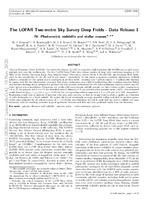The lofar two-meter sky survey: Deep fields data release 1: IV. Photometric redshifts and stellar masses
Abstract
The Low Frequency Array (LOFAR) Two-metre Sky Survey (LoTSS) is a sensitive, high-resolution 120-168 MHz survey split across multiple tiers over the northern sky. The first LoTSS Deep Fields data release consists of deep radio continuum imaging at 150 MHz of the Boötes, European Large Area Infrared Space Observatory Survey-North 1, and Lockman Hole fields, down to rms sensitivities of ∼32, 20, and 22 μJy beam-1, respectively. In this paper we present consistent photometric redshift (photo-z) estimates for the optical source catalogues in all three fields - totalling over 7 million sources (∼5 million after limiting to regions with the best photometric coverage). Our photo-z estimation uses a hybrid methodology that combines template fitting and machine learning and is optimised to produce the best possible performance for the radio continuum selected sources and the wider optical source population. Comparing our results with spectroscopic redshift samples, we find a robust scatter ranging from 1.6 to 2% for galaxies and 6.4 to 7% for identified optical, infrared, or X-ray selected active galactic nuclei. Our estimated outlier fractions (|zphot-zspec|/(1+zspec)>0.15) for the corresponding subsets range from 1.5 to 1.8% and 18 to 22%, respectively. Replicating trends seen in analyses of previous wide-area radio surveys, we find no strong trend in photo-z quality as a function of radio luminosity for a fixed redshift.

